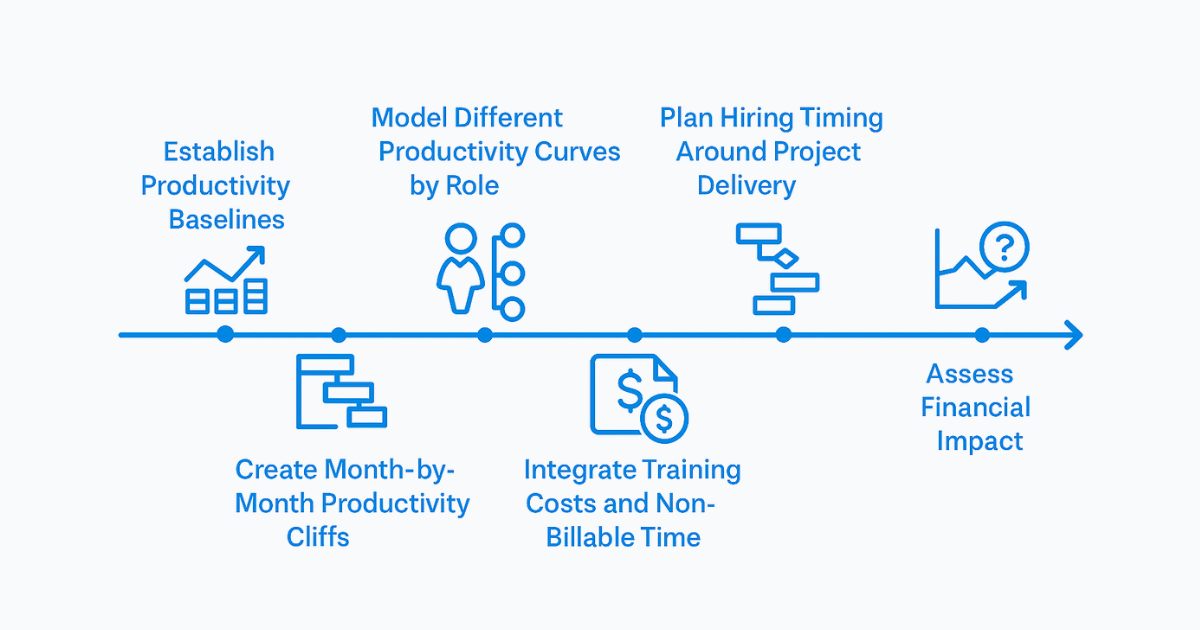Strategic Forecasting Part 3: Modeling Staffing and Productivity Curves for Accurate Financial Planning
Table of Contents
In part one of this series of articles, I discussed “Strategic Financial Forecasting: How Time Tracking Data Transforms Multi-Year Financial Models.” In part two, I focused on “Building a Calendar System that Anchors Multi-Year Models.” In this article, I will explain how to create staffing and resource allocation models using actual productivity curves for more accurate and actionable forecasts.
Accurate financial forecasting allows organizations to anticipate outcomes, manage risk, and make informed decisions about investment and resource allocation. But the challenge lies in the uncertainty of the future and the quality of historic data used to inform estimates. Forecasts are only as reliable as the inputs used to build them. This series focuses on how accurate time tracking data, sometimes viewed as only a necessary evil, actually enables accurate forecasts. This improves outcomes and boosts stakeholder confidence.
Intro:
Most CFOs treat time tracking as operational overhead—a way to monitor productivity and manage resources. Smart financial leaders see it differently: time data reveals your business’s seasonal patterns, capacity limits, and growth potential.
When integrated into financial models, time tracking transforms forecasting from guesswork into precision planning. Whether you’re a seasoned CFO or building your first forecasts, this approach delivers more accurate predictions and better strategic decisions.
Here’s how to turn time data into financial models that actually work.
Developing Staffing and Resource Allocation Models with Productivity Curves
Most financial models treat new employees as either fully productive or unproductive, missing the critical training and ramp-up period that significantly impacts cash flow and project delivery. At CFO Pro+Analytics, we build driver-based projections that require nuances like productivity ramp to create accurate financial models. These factors also influence the cost of goods sold and overall expenses and cash flow, which are essential for accurate financial forecasting and budgeting. The most robust solutions on the market today provide detailed time tracking, laying the data foundation for building sophisticated staffing models that account for realistic productivity curves.
Best Practices for Financial Forecasting
Achieving accurate and reliable financial forecasts requires a commitment to best practices throughout the forecasting process. One key strategy is to employ a blend of quantitative and qualitative forecasting methods, including the analysis of historical data, market research, and expert insights. Staying current with market trends, economic indicators, and regulatory developments is also essential for producing reliable financial forecasts.
Leveraging financial forecasting software and specialized tools like ClickTime can streamline the process and enhance accuracy. Seeking guidance from financial professionals ensures that forecasts are grounded in expertise. It’s also important to align financial forecasts with the organization’s strategic plans and goals, using them as a foundation for informed decision-making and business growth. By following these best practices, businesses can create financial forecasts that not only reflect reality but also drive better outcomes.
Here’s how to build a staffing model that reflects real-world employee development:
Establish productivity baselines from time tracking data. Analyze historical data to understand how new employees progress from 0% to 100% productivity. In service-based businesses, this might be a 3-month curve. For an engineer, it could be up to 6 months. The key is using actual data, not assumptions.
Create month-by-month productivity cliffs. A typical progression is: Month 1 (20% productive), Month 2 (40%), Month 3 (60%), Month 4 (75%), Month 5 (90%), Month 6 (100%). Project-level tracking time tracking enables you to validate these assumptions by comparing billable hours or task completion rates for employees across different tenure levels.
Model different productivity curves by role. Senior developers may reach 85% productivity in month 2, while junior developers may need 4 months to achieve the same level. Customer service representatives might plateau at 90% due to complex product knowledge requirements. Tracking to task-level data helps you identify these role-specific patterns.
Integrate training costs and non-billable time. During the ramp-up period, new employees consume senior staff time for training and mentoring. Time tracking on internal projects and training activities helps you quantify these hidden costs and build them into your staffing model.
Plan hiring timing around project delivery. If you know a new developer will be 60% productive in month 3, and you have a significant project delivery in month 4, you need to hire accordingly. Accurate historical project data helps you understand the lead time required for different roles and skill levels.
The financial impact of proper staffing models is enormous. Consider a consulting firm hiring five new consultants. With a traditional model assuming immediate 100% productivity, you might forecast $500K in additional quarterly revenue. With a realistic ramp-up model based on precise time tracking data, that same hiring might only generate $275K in quarter one but $650K in quarter two as productivity peaks. This difference affects cash flow planning, hiring budgets, and project capacity planning.
The Integrated Approach: Bringing It All Together
The real power emerges when you integrate these three elements I have discussed in this three-part series: labor demand cycles, calendar precision, and staffing curves into a single, comprehensive financial model. This approach provides a clear view of the company’s economic future and supports the development of a comprehensive financial plan. Time entry data becomes the foundation for what I call “reality-based forecasting.”
Here’s what this looks like in practice
Your Q4 forecast accounts for December having 19 working days (not 22), applies a 125% seasonality factor for service demand, and reflects that your two new hires will be 75% and 90% productive, respectively. Meanwhile, your cash flow model accurately reflects the precise impact on working capital, as it is based on modeling actual billing cycles and real capacity constraints. This integrated model enables accurate financial forecasting, ensuring that your projections are not only realistic but also actionable. The ability to generate an accurate forecast is crucial for strategic decision-making and long-term planning.
This level of precision transforms financial planning from educated guessing into a strategic advantage. When you’re presenting to investors or board members, you can confidently explain not just what you expect to happen, but why—backed by actual operational data from your time tracking system. Robust forecasting processes and a well-defined financial forecasting process ensure that your projections are reliable and trustworthy.
Conclusion
The key insight for finance leaders is this: time tracking data isn’t just about payroll compliance or client billing. It’s strategic intelligence that should inform every aspect of your financial planning. Comprehensive tracking capabilities provide the data foundation that sophisticated financial models require, including the 3-statement model—composed of the income statement, balance sheet, and cash flow statement as the core components for comprehensive financial forecasting.
When you’re building forecasts that drive business decisions—whether for fundraising, strategic planning, or operational management, the quality of your underlying data determines the quality of your outcomes. Analytical techniques such as multiple linear regression, which utilize dependent and independent variables, are essential for building robust forecasting models. Time tracking data transforms financial modeling from a necessary evil into a competitive advantage that drives better business outcomes. This approach also supports maintaining fiscal discipline, streamlines the budget preparation process, and leads to improved financial reporting.
By leveraging time tracking and market data, you can gain a deeper understanding of consumer behavior and apply various financial forecasting methods to enhance the accuracy and relevance of your forecasts.
Salvatore’s Bio:
Salvatore Tirabassi is a fractional CFO and financial forecasting expert who helps growing businesses build sophisticated financial models that drive strategic decisions. With expertise in integrating operational data into financial planning, he specializes in creating 3-statement forecasts that serve multiple business functions from budgeting to investor relations. Connect with Salvatore on LinkedIn or learn more about his fractional CFO services at CFO Pro+Analytics.







